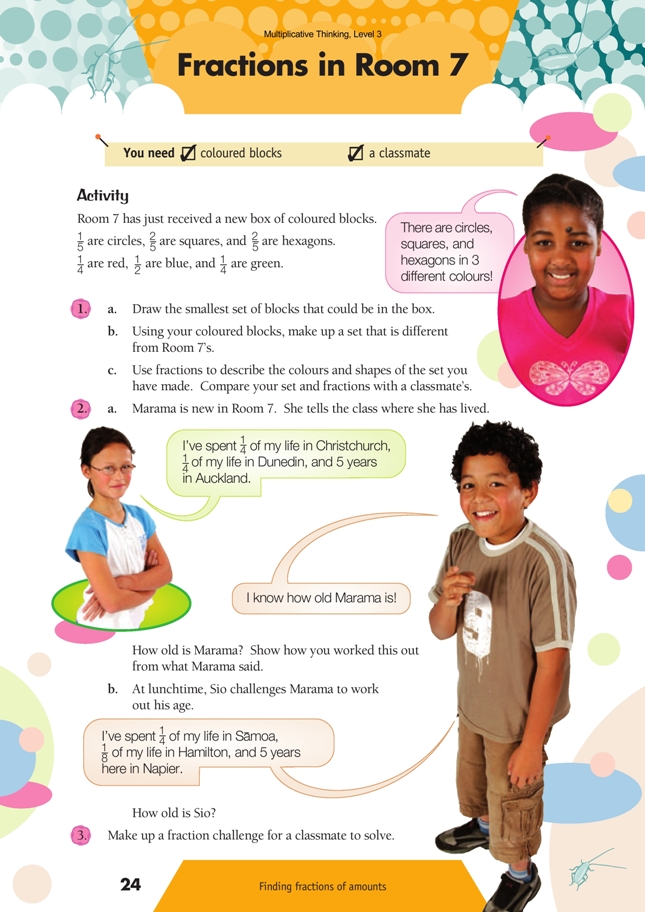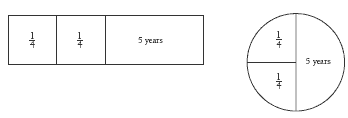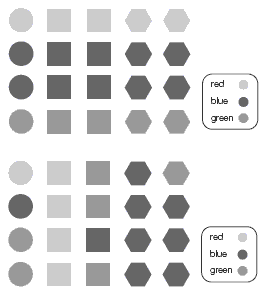This is a level 4 number activity from the Figure It Out series. It relates to Stage 7 of the Number Framework.
A PDF of the student activity is included.
Click on the image to enlarge it. Click again to close. Download PDF (656 KB)
find fractions of whole number to solve problems
Number Framework Links
Use this activity to help your students to consolidate and apply advanced multiplicative part–whole strategies (stage 7) in the domain of proportions and ratios.
FIO, Level 3, Multiplicative Thinking, Fractions in Room 7, page 24
A classmate
In this activity, students need to use multiplicative part–whole strategies to solve problems involving finding the lowest common multiple and simple equivalent fractions.
Students doing this activity will need to:
• have a reasonable recall of multiplication basic facts
• know how to find fractions of groups of objects, for example, 2/5 of 20
• be able to find simple equivalent fractions, for example, 2/4 = 1/2, 1/4 = 2/8.
This activity lends itself to co-operative problem solving. The students, in groups of 3–4, can discuss and solve each problem before they come back together with the whole group to share and compare solution paths.
Introduce question 1 by making attribute blocks available for the students to demonstrate their solutions. Look for students who use number properties rather than materials and, in the group sharing time, ask them to explain what they were doing.
If the students have already done Multiples and Factors, pages 16–17, this question provides an opportunity for reinforcing the idea of lowest common multiples: if you know that 20 is the lowest common multiple of 2, 4, and 5, you can solve the problem easily.
The students should be familiar with the term “multiple” from earlier activities. The lowest common multiple (LCM) is the smallest number that is a multiple of two (or more) numbers, for example, 10 is the smallest number that is a multiple of both 2 and 5. Ask:
• How does knowing about lowest common multiples help with solving this problem? (You have to find the smallest number that can be divided evenly into halves, quarters, and fifths; this is also the LCM of 2, 4, and 5.)
• What is the LCM of 2, 5, and 6? (30)
• What strategies do you use to find the LCM? Is it more efficient to count up in multiples of 2 and check whether they are also multiples of 5 and 6 or to count up in multiples of 6 and check whether they are also multiples of 2 and 5? (Multiples of 6, because only every third multiple of 2 will be a multiple of 6, whereas every multiple of 6 is also a multiple of 2)
For question 2, clarify with the students that 1/4 + 1/4 + 5 years = the whole of Marama’s life.
If students are having difficulty, ask scaffolding questions such as:
• Could you draw a diagram to help you solve the problem?
• If you know that 1/4 + 1/4 = 2/4 and that the other two quarters together equal 5 years, howmany years is one quarter worth?
• Sio spent one-quarter of his life in Tokoroa and one-eighth of it in Hamilton. How many eighthsis this altogether? (three eighths)
• What do you have to do to the quarters before you can add them to the eighths? (Use equivalent fractions to change the one quarter into two eighths.)
• How many eighths are left to cover Sio’s time in Napier? (five eighths)
• If you know that five eighths = 5 years, how many years are equal to 1 whole? (Each eighth = 1 year, so 8 eighths [1 whole] = 8 years)
Extend the problems by challenging the students to describe their own lives in fractional terms. If they haven’t moved towns, they could describe their family or something they own, for example:
• “One-third of my family is male, four-sixths of my family is under the age of 15, and I have 1 brother.”
• “I collect Super 14 cards. Three-eighths of my collection is Highlanders players, one-quarter is the Blues, one-eighth is the Chiefs, and I have 12 Hurricanes cards. How many cards do I have altogether?”
Answers to Problems
1. a. Practical activity. The smallest set will be 20 blocks. The colours need to be 5 red, 10 blue, and 5 green, and with the shapes 4 circles, 8 squares, and 8 hexagons.
There are many ways of distributing the colours across the shapes. Here are two
ways:
b.–c. Practical activity. Sets and fractions will vary.
For example, 1/6 red, 2/3 blue, 1/6 green; 1/4 circles, 1/2 squares, 1/4hexagons. The smallest set that matches these fractions is 12 blocks: 2 red, 8 blue, 2 green; 3 circles, 6 squares, and 3 hexagons.
2. a. Marama is 10 yrs old. Explanations may vary. One possible way to work this out is: 1/4 plus 1/4 is 2/4 or 1/2 , so Marama’s 5 yrs in Auckland is also 1/2.
If 1/2 is 5 yrs, then 1/4 is 2 1/2 yrs. 2 1/2 + 2 1/2 = 5, so Marama is 2 x 5 = 10 yrs old.
b. 8 yrs old. (1/4 = 2/8. 1/8 + 2/8 = 3/8 . 3/8 + 5/8 = 1 whole, so the
5 years in Napier is of Sio’s age and 1 yr = 1/8. 5 + 1 + 2 = 8)
3. Fraction challenges will vary.


